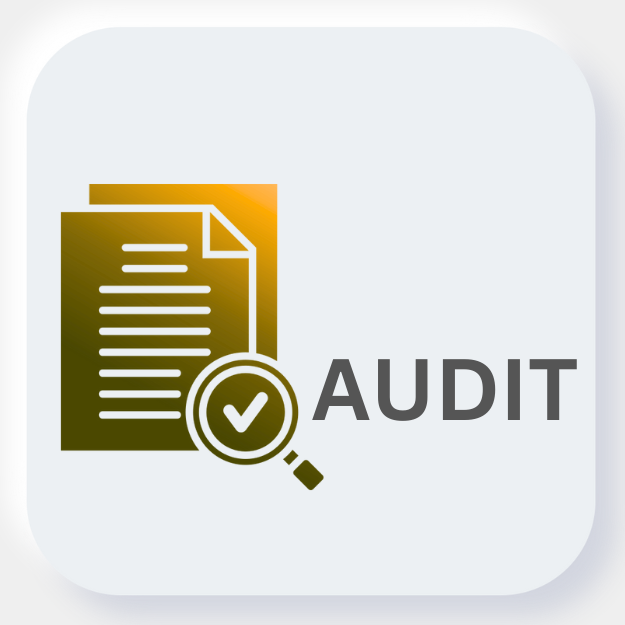Introduction
From newcomers to seasoned practitioners applying for senior roles, a successful internal audit
interview hinges on your understanding of auditing principles, processes and best practices.
In this guide, go through the most frequently asked internal
audit interview questions along with the
best tips on how to answer them. By the end, you'll now feel more comfortable making an impact on your
interviewer that lasts.
Also Read: Top CA Firms in India For
Articleship
2. Internal Audit Interview Questions and Answers
Applicability of Internal Audit
This is a basic question, but it's important to know the answer to this one.
If a company meets any of the below limit then it will need to conduct internal audit (Companies Act
2013):
- Turnover - ₹200 crore or more
- Outstanding loans or borrowings exceeding ₹100 crore
- Paid-up share capital of ₹50 crore or more
- Outstanding deposits over ₹25 crore
Q. Importance of Internal Auditing
Internal audits help organisations manage their risk, remain compliant and improve efficiency. The
main purpose of internal audits is supplying independent assurance that an enterprise’s corporate
governance and related processes work effectively.
They help to detect fraud, increase operational efficiency and ensure the accuracy of finance
reporting. Internal audit interview questions related to this area are mostly about the role of
internal audits in risk management and corporate governance
- Turnover - ₹200 crore or more
- Outstanding loans or borrowings exceeding ₹100 crore
- Paid-up share capital of ₹50 crore or more
- Outstanding deposits over ₹25 crore
Q. What Are the Steps in an Internal Audit?
An organized approach helps create a complete audit. The key steps include:
- Planning: also Establish the scope and objectives, and allocate resources for the audit.
- Fieldwork: Collect and assess financial and operational information.
- Testing: Conduct substantive and control testing to substantiate data integrity.
- Reporting: Document the findings, offer recommendations and share them with stakeholders
- Follow-up: Ensure corrections have been implemented for any of the above.
Internal audit interview questions also require candidates to elaborate on these steps with practical
examples of the audits performed.
Q. What Are the Key Components to Conduct an Internal Audit?
The prerequisites for an internal auditor to carry out an audit are:
- A clear internal audit plan.
- Financial records, policies and operational data for conducting analysis.
- Knowledge of risk assessment methodologies and regulatory compliance.
- Also, you must have great communication skills to be able to interact with management.
Common internal audit interview questions also test a candidate’s aptitude to link audit
objectives to business objectives.
Q. How do you manage conflicts that happen during an internal audit?
The information might be very different from the existing processes in sold companies, resulting in
some of the audit findings that bring disagreement. Effective auditors:
- Open the lines of communication to ease worries.
- Employ a negotiation focus for a common ground solution.
- Writing should remain objective and professional, not reliant on who is paying.
Q. What’s in an Internal Audit Plan?
An audit plan includes:
- Objectives and scope.
- Resources and timeline.
- Audit methodology and data collection methods.
- Key risks and control testing.
Employers want to see candidates understand the importance of a well-planned audit so this is a
common internal audit interview question.
Q. What do statutory auditors look for when reviewing internal audit reports?
For this you can refer to the following answer. But also make sure to study SA 610 for this. This
will help you develop a better understanding of this topic. Statutory auditors assess:
- Independence and Objectivity of Internal Auditors
- The skill level of the internal audit team.
- Quality of documentation and audit reports
- The adequacy of internal controls and risk management frameworks
Hence, this clarity will be helpful in your internal audit interview for answering questions.
Q. What Are the Main Differences Between Statutory and Internal Audits?
| Feature |
Internal Audit |
Statutory Audit |
| Objective |
Improve internal processes |
Provide independent assurance |
| Scope |
Continuous and organisation-wide |
Annual and focused on financials |
| Reporting |
To management |
To shareholders and regulators |
Understanding these differences is crucial for answering internal audit interview questions.
Q. What are Substantive Tests?
Substantive tests verify the financial statements by:
- Reviewing supporting documents like invoices and contracts.
- Performing analytical procedures to identify irregularities.
- Recalculating transactions to ensure accuracy.
You will be asked to describe how you use substantive testing in audits in response to internal audit
interview questions.
What is vouching? How is it used in the auditing function?
Think of vouching as the Sherlock Holmes part of auditing.
It’s not just flipping through invoices and stamping “checked” on them. Nope. It’s a full-on
investigation.
At its core, vouching means the auditor is verifying whether every transaction recorded in the books
actually happened, and that it happened for a valid reason. In simple words—“Jo likha hai, kya woh
sach mein hua bhi tha?”
So, what does vouching include?
- Checking supporting documents – bills, receipts, vouchers, bank statements…basically anything
that proves the transaction happened.
- Verifying date, amount, and authority – Is the amount matching? Was the payment authorized? Was
the transaction made within the correct accounting period?
- Looking out for fakes – Yes, fake invoices and bogus entries exist, and vouching helps catch
those red flags before they become full-blown scandals.
- Cross-checking with books – Entries in ledgers and journals must align with the physical proof.
No jugaad allowed here.
Q. What are the key qualities of an internal auditor?
Internal auditors have:
- Strong analytical and problem-solving skills.
- Ethical integrity and independence.
- An internal auditor must enjoy independent status at all times. But he must closely associate
himself with the management to identify loopholes and improve processes
- Attention to detail and a process improvement mindset.
- Good communication and negotiation skills.
These are often asked in internal audit interview questions.
Q. How do you detect fraud in reimbursements?
Reimbursement expenses - the perfect spot to sneak in a little “chai-paani” if no one's watching. But
guess what? Auditors are watching.
So how do you catch fraud in reimbursement claims? It’s not rocket science, but it is smart
auditing.
Step-by-Step on Catching Reimbursement Frauds:
- a. Scrutinize Every Bill.
Zoom in, cross-check, and ask—
Is the date even valid?
Was this bill issued on a Sunday? Red flag.
Same taxi bill submitted twice? Double check!
- b. Look for Personal Expenses Disguised as Official.
“Client lunch” at a movie theatre? Really? Auditors must ensure the claimed expenses actually
relate to the business and not a weekend getaway.
- c. Compare with Company Policies.
Is the claim within the allowed limit? Did the employee take a business class flight when policy
allows only economy? If yes, then welcome to Fraudistan.
- d. Identify Pattern Players.
Some employees always have “emergency” cab rides. Or claim “food expenses” for the same amount
every week. These repeat offenders love routine - auditors love catching them.
- e. Cross-verify with Attendance and Location.
Claiming reimbursement for a hotel in Delhi while the person was marked present in Mumbai?
Either they teleport… or they lie.
- f. Duplicate Claims = Busted.
Same bill submitted under two heads—travel + client meeting? Nice try. But not nice enough.
Bonus Tip: Use data analytics or simple Excel filters. Group by employee name, sort
by expense type, and the outliers will shine.
Fraud indicators are:
- Duplicate claims for the same expense.
- Falsified receipts and altered documents.
- Expenses submitted outside company policy.
Internal audit interview questions frequently touch on the subject of fraud detection; you must talk
about your investigative methods.
Q. What is the difference between vouching & verification?
Vouching vs Verification – They sound similar but trust me, they’re totally different.
Okay, let’s break it down. Both vouching and verification are like the Batman and Robin of auditing
- but they’ve got different jobs.
Vouching
This is where the auditor becomes Sherlock Holmes. Vouching is all about checking transactions.
“Salary paid ₹30,000” – okay, show me the proof. Salary sheet? Bank statement? Signature of the
employee? Great!
It answers one big question: Did this transaction even happen, or is someone making things up?
Verification
Verification is more about checking assets and liabilities.
You’re not just asking “Did we buy this machinery?” You're asking: “Is this machine still lying in
the factory?”, “Is it in good shape?”, “Are we showing its correct value in the books?”
It answers: Is this thing real, still around, and rightly valued?
Quick Recap:
- Vouching = Prove the transaction happened.
- Verification = Prove the asset exists and is fairly valued.
Q. What is the difference between process & control?
Process vs Control – Not Twins, Just Cousins
Now, this is where most students mix things up. Yes, process and control work together, but they’re
not the same.
Process – The “How Things Work” Manual
Think of a process like a daily routine.
Wake up → Brush teeth → Coffee → Class → Netflix.
Similarly, a business process could be: Purchase request → Manager approval → Vendor selection →
Payment.
It’s the flow of work.
Control - is the Protective Shield
Controls are those smart checkpoints within the process that say - “Wait a second, are we sure this
is right?” For example:
- Expenses above ₹1 lakh need CFO approval.
- Password must be changed every 30 days.
Controls don’t stop the process - they make sure it doesn’t go off-track.
In short:
- Process = What happens.
- Control = What ensures it happens right.
Auditing isn’t just ticking boxes. It’s like running a quality check on a system - figuring out
what’s real, what’s working, and what needs fixing.
Q. Difference between Top Down & Bottom Up Approach
Top-Down vs Bottom-Up Approach
Let’s say you're building a company or planning a group study session.
There are two ways to go about it: Top-Down (CEO vibes) or Bottom-Up (grassroots genius). Let’s
decode both.
Top-Down Approach: This is the “I have a plan, now you follow it”
style.
Decisions come from the top management or leaders, and then it flows down to the rest of the team.
Where it’s used:
- Strategic planning
- Budgeting
- Policy-making
- Enterprise-level audits
Pros:
- Clear vision from the start
- Faster decision-making
- More control and consistency
Cons:
- Less input from ground-level employees
- May ignore practical difficulties
- Can feel like dictatorship if not handled well
Bottom-Up Approach – Ground-Level First:
Here, the ideas, data, or feedback come from the base level, and then get compiled and passed upward
for decisions.
Where it’s used:
- Operational audits
- Feedback-driven product development
- Risk assessment
- Process improvements
Pros:
- Practical and grounded insights
- Higher employee involvement
- More flexible and adaptive
Cons:
- Slower process
- Harder to align with top-level strategy
- Risk of too many opinions and confusion
| Feature |
Top-Down Approach |
Bottom-Up Approach |
| Starts From |
Top management |
Operational staff / base level |
| Direction |
From top to bottom |
From bottom to top |
| Focus |
Strategy, vision |
Practical implementation |
| Decision-making |
Centralized |
Decentralized |
| Example |
Budget planning by CFO |
Expense feedback from departments |
Both approaches are valid—it all depends on what you’re trying to achieve.
Q. What is Internal Financial Control (IFC)?
IFC ensures:
- Operational efficiency and risk mitigation.
- Reliable financial reporting and regulatory compliance.
- Well-documented policies and accountability.
Many internal audit interview questions test candidates’ knowledge of IFC implementation.
Q. Differentiate between ICFR & IFC
ICFR vs IFC – Same-Same but Actually Different.
If you’ve ever looked at “ICFR” and “IFC” and thought, “Yaar, isn’t this the same thing?” - you're
not alone.
But no, they aren’t identical twins. They’re more like siblings with different goals. Let’s sort
this out once and for all.
IFC – Internal Financial Controls
This is the umbrella term. It covers all the policies and procedures that ensure:
- the company’s operations run smoothly,
- assets are safeguarded,
- financial reporting is reliable, and
- rules and laws are being followed.
Focus Area:
Everything financial + operational + compliance-related.
So yes, it includes internal controls over:
- Operational processes
- Compliance with laws
- Financial reporting
- Asset protection
Basically, IFC covers everything.
ICFR – Internal Controls over Financial Reporting
This is a subset of IFC. ICFR focuses only on controls that affect the financial statements. Think of
it as the part of IFC that cares about whether your Balance Sheet and P&L are telling the truth.
Focus Area:
Only those controls that help prevent errors or fraud in financial reporting.
So it covers things like:
- Journal entries
- Closing procedures
- Revenue recognition
- Expense booking
- Financial disclosures
ICFR is extremely important when you're signing off the financials.
| Feature |
IFC (Internal Financial Controls) |
ICFR (Internal Controls over Financial Reporting) |
| Scope |
Broad – includes financial, operational & legal |
Narrow – only financial reporting |
| Who Needs It? |
All companies under Companies Act, 2013 |
Listed companies + some others based on criteria |
| Purpose |
Ensure everything runs as per law & plan |
Ensure true and fair financial statements |
| Relation |
ICFR is a part of IFC |
ICFR is one component under the bigger IFC umbrella |
Q: Chief audit executive has dual reporting to the board and the senior management.
Why?
Dual Reporting of the Chief Audit Executive – Why Two Bosses Are Better
Than One?
If you’ve heard that the Chief Audit Executive (CAE) reports to both the Board and Senior Management
and thought, “Wait, isn’t that confusing?” — let’s clear it up.
Actually, it’s not confusion, it’s good governance.
Who Exactly Does the CAE Report To?
- Functionally → The Board / Audit Committee
- Administratively → Senior Management / CEO / CFO
Yep, two reporting lines. And there's a solid reason behind this.
Q. Why Dual Reporting Exists:
- 1. Independence & Objectivity: If the CAE reports only to senior management,
the whole “internal audit is independent” thing falls apart. That’s why functional reporting to
the Board keeps the audit unbiased and credible.
- 2. Operational Support: But hey, auditors still need an office, a laptop, and
maybe a coffee machine. That’s where administrative reporting to management comes in. They take
care of budgets, day-to-day issues, etc.
The Board tells the CAE what to audit and ensures they have the freedom to do it right. Senior
Management helps with how the work gets done (resources, support, etc.)
Q. Explain P2P, H2R, O2C
Internal Audit – Let’s Talk P2P, H2R & O2C (Not WiFi Passwords, I
Promise)
If those three look like some secret code, don’t worry—you’re not alone. But in the world of internal
audit, these are the big three processes you must know.
Let’s decode them one by one - and learn how to audit them like a pro.
1. P2P – Procure to Pay
"From ordering a pen to paying for a truckload of raw material—this is your P2P cycle."
What You Audit:
- Purchase Requisition → PO → GRN → Invoice → Payment
- Are purchase orders authorized?
- Was the material actually received (check GRN)?
- Are invoices matched with POs and GRNs?
- Was payment made within the approved limits and timelines?
Common Red Flags:
- Duplicate payments
- Fake vendors
- Payments without GRN
- PO created after the invoice was received (yep, shady stuff)
Your Audit Goals:
- Ensure proper approvals
- Validate vendor authenticity
- Match all three: PO, GRN & Invoice (called 3-way match)
- Check segregation of duties (no single person should do everything)
2. H2R – Hire to Retire
"From Day 1 to last working day—this process tracks every employee journey."
What You Audit:
- Hiring → Onboarding → Payroll → Appraisal → Exit
- Is hiring done through approved channels?
- Are payroll payments accurate and supported?
- Are PF, TDS, and other deductions correctly calculated and deposited?
- Was full & final settlement done on time?
Common Red Flags:
- Ghost employees (salary paid to someone who doesn’t exist!)
- Wrong leave encashment
- Salary structure not matching appointment letter
- Improper exit clearance
Your Audit Goals:
- Check for dummy entries in payroll
- Ensure statutory compliance (PF, TDS, ESIC)
- Verify approval trail for promotions/increments
- Confirm exit process and documentation
3. O2C – Order to Cash
"The journey from getting an order to receiving the payment—it’s all in O2C."
What You Audit:
- Customer Order → Delivery → Invoice → Receipt of Payment
- Are customer orders properly authorized?
- Was delivery done on time and acknowledged?
- Were invoices raised correctly?
- Is the collection happening as per terms?
Common Red Flags:
- Delayed invoicing = delayed cash flow
- Fake sales (yes, just to boost targets)
- Credit given beyond limit
- Receivables not followed up
Your Audit Goals:
- Ensure timely billing
- Validate revenue recognition policy
- Review of outstanding receivables ageing
- Check for internal approvals for credit limits
Pro Tip: When you audit any of these processes—ask for SOPs (Standard
Operating Procedures). If SOPs don’t exist or no one follows them—it’s your time to shine (and raise
that audit point).
In a Nutshell:
- P2P = Buy smart, pay smarter
- H2R = Employees in, employees out—fairly and compliantly
- O2C = Don’t just sell—collect your cash too!
Q: How do you audit cash and cash equivalents?
- Balances from the general ledger and bank statements should be reconciled.
- Physically verify cash on hand and review cash handling procedures.
- Assess internal controls over cash transactions.
Employers ask internal audit interview questions on cash auditing techniques.
Q: COSO Framework
Internal control isn’t just about keeping things “under control.” It’s a structured system that helps
an organization run better, stay compliant, and avoid fraud.
And the COSO framework?
It consists of five key components that every internal control system must have.
1. Control Environment – The Vibe Check
This is the foundation.
It's all about the tone at the top—leadership attitude, ethics, values,
and the overall culture.
It Includes:
- Code of conduct
- Integrity & ethical values
- Management’s operating style
- Organizational structure
- Roles & responsibilities
If the bosses don’t care about controls, no one else will.
2. Risk Assessment – Spot the Trouble Before It Hits
Before you can control anything, you need to know what could go wrong.
Includes:
- Identifying risks
- Analyzing how bad the risks are
- Figuring out what might trigger them
- Understanding how fast they might hit
3. Control Activities – The Action Plan
These are the actual measures you put in place to tackle the risks.
It Includes:
- Approvals, authorizations
- Reconciliations
- Verifications
- Segregation of duties
- Physical controls
Think of these as the locks, alarms, and firewalls of your business process.
4. Information & Communication – The Messenger Service 📢
Even the best controls fail if people don’t know about them.
Includes:
- Sharing policies and procedures
- Timely reporting of issues
- Open channels between departments
- Communication with external parties
Controls must be known, not just shown.
5. Monitoring Activities – The Constant Watchdog
Set it and forget it? Nope. Controls need regular check-ups to see if they’re still working.
Includes:
- Ongoing evaluations
- Internal audits
- Reviews and follow-ups
- Corrective actions
Because even the best systems need a little maintenance.
COSO’s 5 Components
| Component |
Purpose |
| Control Environment |
Sets the tone of integrity and ethics |
| Risk Assessment |
Spots what could go wrong |
| Control Activities |
Implements actions to prevent/control risks |
| Info & Communication |
Ensures everyone knows what’s happening |
| Monitoring Activities |
Keeps controls fresh and functional |
Q. What is the Three Lines of Defense Model?
The Three Lines of Defense Model helps to clarify roles and responsibilities in risk management and
control.
First Line: Operational management and internal controls.
Second Line: Risk management and compliance functions.
Third Line: Internal audit providing independent assurance.
This is a widely recognized model often included in internal audit interview questions.
Q: Difference Between a Management Audit and an Operational Audit?
Management Audit vs Operational Audit – Not Twins, Just Distant
Relatives
Okay, both are audits. Both involve reviewing what’s going on inside a company. But the why, what,
and how behind each are totally different. Let’s break it down.
Management Audit
Think of it as a 360-degree feedback session... but for the management team. It’s an audit of the
brains behind the business.
What it checks:
- Are the managers taking effective decisions?
- Is leadership aligned with the company's goals?
- Are strategies being implemented as planned?
- Are resources being used efficiently?
Focus: Effectiveness of policies, planning, and decision-making by
the top
management. It’s less about “Are they doing the work?” and more about “Are they doing the right
work?”
Outcome:
- Suggestions for better leadership practices
- Aligning goals with execution
- Improving long-term decision-making
Operational Audit – The “Process Deep-Dive”
This one zooms in on day-to-day operations and checks: "Are we doing our routine activities as
smartly as we could?" In short, it’s an audit of how the company’s engine is running.
What it checks:
- Are workflows efficient?
- Are costs in control?
- Are there any wastages or delays?
- Are internal controls strong?
Focus: Processes, procedures, and internal systems that keep the
business running
smoothly. It’s about how things are done on the ground.
Outcome:
- Cost-cutting opportunities
- Process improvements
- Better internal controls
| Feature |
Management Audit |
Operational Audit |
| Focus |
People, strategy & decision-making |
Processes, efficiency & internal control |
| Scope |
Top management's effectiveness |
Day-to-day operations |
| Goal |
Improve leadership & governance |
Enhance efficiency & reduce waste |
| Nature |
More qualitative |
Mix of qualitative + quantitative |
| Conducted by |
Internal or external experts |
Mostly internal auditors or consultants |
So, while management audit looks at “who’s driving the car and in which direction,” operational audit
checks “how well the engine is running and if we’re wasting fuel.”

.png)












.png)





























